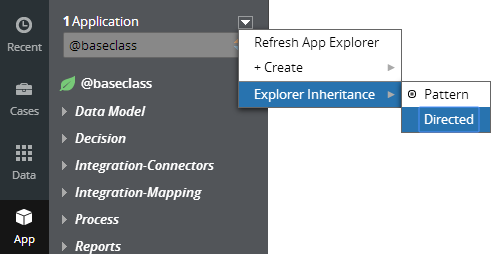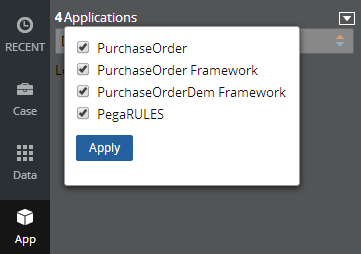Guardrails compliance score
Valid from Pega Version 7.1.5
The Application Guardrails landing page has been enhanced to help you build more guardrail-compliant applications. Increase transparency and accountability on your projects by responding to the following compliance score metrics:
- A weighted compliance score (0-100) based on warnings, severity, and justification
- A percentage of compliant rules in your application
- Total number of rules in your application
- Total number of rules in your application with warnings (justified and unjustified)
Additional metrics include alert and interaction count trends over the last four weeks.
For more information, see Guardrails compliance score.
Directed inheritance view in Application Explorer
Valid from Pega Version 7.1.5
You can now specify which inheritance model is used to populate classes in the Application Explorer. From the top level menu, use the “Explorer Inheritance” option to choose between:
- Pattern: only display class names whose prefix matches the root node class name.
- Directed: first display classes that explicitly name the root node as the parent class; then display classes with pattern inheritance.

By default, the Application Explorer loads using Pattern inheritance.
Save Application Explorer filter selections
Valid from Pega Version 7.1.5
Application scoping control selections made in the Application Explorer are now persisted between sessions. These preferences are stored in an operator record on an access group level. If you delete (and later re-add) an access group on your operator form, the application scoping control defaults to all layers selected:

External access control DASS
Valid from Pega Version 7.1.5
A new Dynamic Admin System Setting (DASS) controls the Designer Studio's access to external systems, specifically the PDN RSS feed found on the home page.
By default, Pega-Desktop.AllowAccessToExternalSystem is set to TRUE. Update this setting to FALSE to hide the PDN RSS feed and ensure that no RSS fetch is performed.
Execute Tests service now supports flows, case types, and PegaUnit test suites
Valid from Pega Version 7.3
The Execute Tests service now supports running flows, case types, PegaUnit test suites. Use the Execute Tests service to validate the quality of your builds after every build run.
For more information, see Running PegaUnit test cases and test suites with the Execute Tests service.
Support for creating PegaUnit test suites
Valid from Pega Version 7.3
You can now create PegaUnit test suites to group related PegaUnit test cases and run them in the order that you specify. For example, you can create smoke tests to verify that critical application functionality is working as expected.
For more information, see PegaUnit test suites.
Enable and disable functionality with feature toggles
Valid from Pega Version 7.3
You can enable and disable functionality in your application for development and testing by creating feature toggles on the Toggle Management landing page. You can also manage the toggles in your application from the landing page. For example, you can review the toggles that you want to retire at the end of a release, or migrate a toggle to other applications by changing the associated ruleset.
For more information, see Creating a toggle.
Support for following users in the Pega Express and Case Manager portals
Valid from Pega Version 7.3
You can now follow users in both the Pega Express and Case Manager portals. Posts that are made by users whom you are following are displayed in your Pulse activity feed in your dashboard. In addition, an icon indicates whether followed users are online.
For more information, see the following help topics:
Enhancements to the Send Email smart shape
Valid from Pega Version 7.3
The following enhancements have been made to the Send Email smart shape:
- You can now configure the Send Email smart shape in Pega Express.
- You can use templates, such as a rejection template, in your email.
- You can use property values, which allow you to insert the value of a field in your case type, such as First Name, within the email.
- You can insert a link to the case ID in your email.
- You can more quickly configure your recipient list by using two options, instead of one, to send messages to either a list of email addresses or to fields.
- You can choose to send either all case attachments in an email, or you can send attachments of a specified attachment category or an attachment type field. You can specify multiple attachment categories and attachment type fields.
For more information, see the following help topics:
Improved requestor management
Valid from Pega Version 7.3
From the Requestor Management landing page, you can now manage active requestors and debug their activity on all nodes in the cluster, including the current node and remote nodes. You can view performance and requestor details; start the Tracer or Clipboard tool; profile, interrupt, or terminate the selected requestor; and estimate the data size of all requestors on the selected node.
For more information, see Managing requestors.

